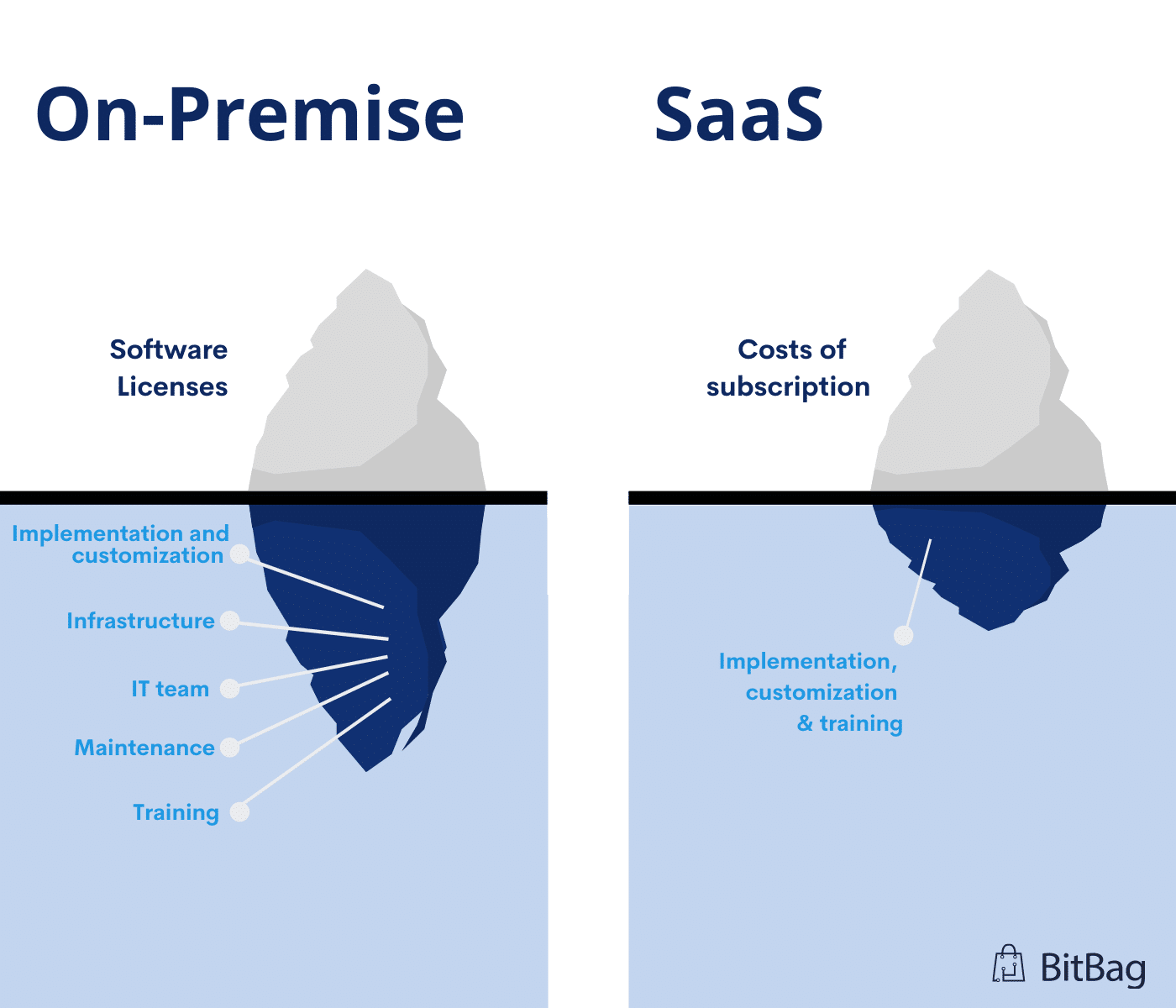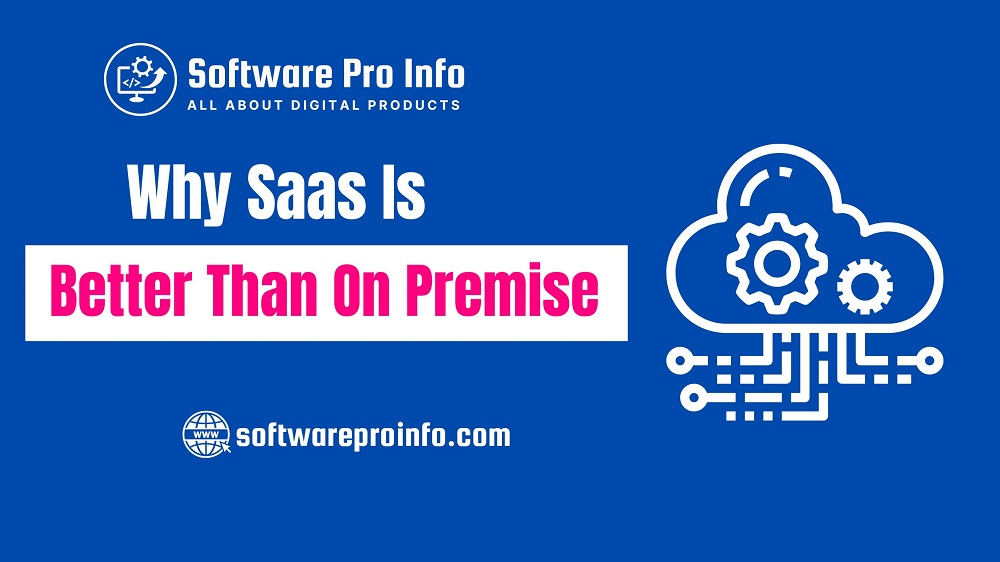SaaS offers cost efficiency and scalability unlike on-premise solutions. It eliminates the need for physical infrastructure and upfront investments.
Exploring the realm of software deployment, businesses today face a pivotal decision between SaaS (Software as a Service) and on-premise solutions. This choice significantly impacts their operational efficiency, cost management, and technological adaptability. SaaS stands out as a superior option for many reasons.
It provides businesses with the flexibility to scale services according to demand, ensuring that resources are not underutilized or overstretched.
With SaaS, companies enjoy the latest updates and security features without additional costs or manual intervention. This model supports remote work environments seamlessly, making it ideal for today’s mobile and dynamic workforce.
The shift towards SaaS is not just a trend but a strategic move for businesses aiming for growth and resilience in a fast-paced digital landscape.

Credit: www.rillion.com
Why Saas Is Better Than On Premise
Opting for SaaS offers unparalleled convenience and cost efficiency, eliminating the need for extensive hardware investments. It ensures businesses can scale effortlessly, adapting to market demands without the complexities of on-premise solutions.
Cost Efficiency
Opting for Software as a Service (SaaS) often results in significant cost savings for businesses. Traditional on-premise solutions require substantial upfront investments in hardware, software licenses, and IT infrastructure. In contrast, SaaS operates on a subscription-based model with typically lower initial costs, providing a more economical approach to accessing technology.
- Reduced Upfront Investment: SaaS eliminates the need to purchase expensive hardware and software, which can be prohibitive for small and medium businesses.
- Predictable Monthly Fees: With a subscription model, companies can budget more effectively, as they know their exact monthly costs for the service.
- No Maintenance Costs: The SaaS provider is responsible for maintenance, updates, and upgrades, removing the need for in-house IT staff to manage these tasks.
Scalability And Flexibility
The ability to scale services according to business needs is a hallmark of SaaS solutions. Companies can adjust their usage and subscription levels with ease, which is not as straightforward with on-premise systems.
- Easy Adjustments to Scale: Businesses can quickly scale up or down based on their current requirements without worrying about purchasing additional hardware or software licenses.
- Tailored Subscriptions: SaaS providers often offer a range of plans and options, allowing companies to select the features they need and avoid paying for unnecessary extras.
Accessibility And Collaboration
One of the strongest advantages of SaaS is its accessibility from any device with an internet connection. This flexibility empowers teams to collaborate in real-time, regardless of their physical location.
- Remote Access: Employees can access the software from anywhere, which is invaluable for remote teams or those who travel frequently.
- Unified Workspaces: SaaS often provides collaborative spaces where teams can work together simultaneously on projects, streamlining workflows and communication.
Quick Deployment And Ease Of Use
SaaS applications are renowned for their swift deployment and user-friendly interfaces. Companies can get started with SaaS offerings much faster than with complex on-premise installations that can take weeks or even months.
Deploying a SaaS solution typically involves a straightforward setup process with minimal configuration. Users can often begin using the software almost immediately after subscribing. This quick deployment is particularly beneficial for companies that need to implement solutions rapidly to meet project deadlines or business objectives.
Enhanced Security And Compliance
Security is a top concern for any business, and SaaS providers invest heavily in safeguarding their infrastructure. They employ robust security measures that many individual companies cannot match due to resource constraints.
- Regular Security Updates: SaaS providers continuously update their systems to protect against the latest security threats.
- Compliance Standards Adherence: Providers often ensure their services comply with industry regulations, reducing the compliance burden on the subscribing business.
Focus On Core Business Activities
By leveraging SaaS, companies can redirect their attention and resources to core business activities rather than IT management. This shift can lead to increased productivity and innovation.
- Reduced IT Workload: With the SaaS provider handling technical issues, in-house IT staff can focus on strategic initiatives that drive business growth.
- Faster Innovation Cycles: SaaS applications are updated more frequently than traditional software, providing businesses with the latest features and functionalities without delays.
Understanding the superiority of SaaS over on-premise solutions is critical for businesses aiming to maximize their efficiency and competitiveness. By embracing the flexibility, cost-effectiveness, and cutting-edge features of SaaS, companies can not only streamline their operations but also foster a more dynamic and collaborative work environment.
Saas Vs On Premise
SaaS solutions offer unparalleled scalability and flexibility, outshining on-premise alternatives with their ease of access and lower upfront costs. With automatic updates and no need for physical infrastructure, SaaS stands as a cost-effective and maintenance-free choice for businesses aiming to stay agile in a fast-paced market.
Saas Vs On-premise: A Comparative Analysis
In the realm of software solutions, the debate between SaaS (Software as a Service) and on-premise installations is a pivotal one for businesses. The choice between these two can significantly impact operations, costs, and scalability. Let’s delve into the specifics of each to understand why many consider SaaS the superior option.
Understanding Saas
SaaS stands for Software as a Service, and it is revolutionizing the way companies access and use software. Unlike traditional methods, SaaS offers:
- Accessibility: With an internet connection, SaaS applications are available anywhere, promoting remote work and flexibility.
- Cost-effectiveness: It eliminates the upfront cost of purchase/installation, as well as ongoing costs like maintenance and upgrades.
- Scalability: Users can easily scale their subscription based on their current needs, without the need to purchase additional hardware or software.
The Case For On-premise Solutions
On-premise software is the traditional approach where software is installed directly onto a user’s computer or server. This model presents:
- Control: Users have full control over the environment, which can be crucial for compliance or security requirements.
- Performance: With the right infrastructure, on-premise solutions can offer robust performance without the latency that can sometimes occur with internet-based applications.
Why Saas Is Often The Preferred Choice
Many businesses are migrating to SaaS for its compelling advantages:
- Reduced IT Workload: SaaS providers handle the IT burden of maintaining and updating the software, freeing up company resources.
- Immediate Upgrades: Software updates are rolled out by the provider without user intervention, ensuring access to the latest features and security patches.
- Predictable Costs: A subscription model allows for predictable budgeting with no surprise expenses for hardware or software upgrades.
Considerations For On-premise Deployments
While SaaS is on the rise, on-premise solutions shouldn’t be dismissed outright, as they offer:
- Customization: On-premise systems often provide more room for tailored customization to meet specific business processes.
- One-time Investment: Despite higher initial costs, on-premise software can be more economical in the long run, particularly if the business has a stable and predictable software usage.
The Bottom Line: Saas Vs On-premise
As we compare SaaS and on-premise, it’s clear that SaaS has distinct advantages, especially for businesses looking for flexibility, cost savings, and ease of use. On-premise solutions still have their place, particularly in scenarios that demand maximum control and customization.
The choice between SaaS and on-premise will ultimately depend on the specific needs and resources of the business.

Credit: bitbag.io
FAQs About Why Saas Is Better Than On Premise
What is the benefit of SaaS over on-prem?
SaaS offers lower upfront costs, no need for hardware, and automatic updates.
Why is SaaS better than hosted?
SaaS is easier to access, requires no manual maintenance, and stays up-to-date automatically.
What is an advantage of SaaS?
SaaS provides flexibility, scalability, and reduces the IT management burden.
Why is cloud better than on-premises?
Cloud solutions are more cost-effective, scalable, and accessible from anywhere.
Final Words
Embracing SaaS offers flexibility, scalability, and cost-effectiveness that on-premise solutions often lack. It provides the agility businesses need to adapt in a fast-paced market.
By choosing SaaS, companies unlock the potential for innovation and streamline their operations. It’s a smart move for any enterprise aiming to stay competitive and responsive to change.

At Software Pro Info, we focus on empowering users with in-depth information about digital products and SaaS applications. Our Team provides expert reviews and exclusive deals, including lifetime deals and discounts, to help you find the best tools and services for your needs.







